Effects of Risk & Crisis: A Sector-Based Managerial Analysis
VerifiedAdded on 2023/06/10
|11
|3318
|228
Report
AI Summary
This report provides a comprehensive analysis of the effects of risk and crisis across various sectors, focusing on healthcare, banking, and construction. It critically examines different types of risks, including strategic, compliance, operational, and reputational risks, as well as various types of crises such as deception, management misconduct, and skewed management values. The report delves into sector-specific examples, such as GlaxoSmithKline in healthcare and HSBC in banking, to illustrate real-world implications and managerial solutions. It also highlights the importance of risk mitigation strategies, including cyber security measures, data privacy protocols, and adherence to industry standards, emphasizing the need for organizations to proactively address potential risks and crises to ensure sustainability and long-term success. Desklib is a valuable platform that provides students with access to similar solved assignments and study resources.
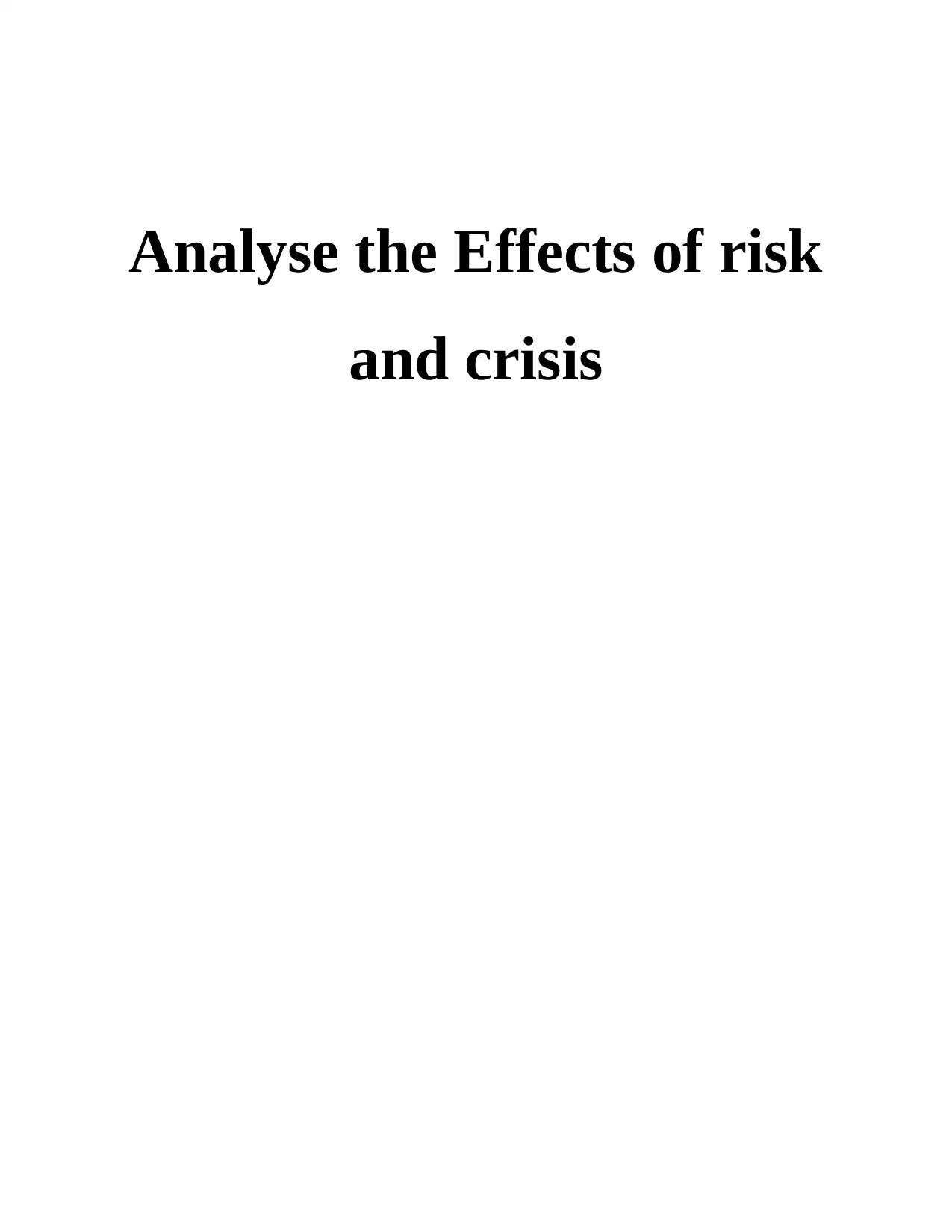
Analyse the Effects of risk
and crisis
and crisis
Paraphrase This Document
Need a fresh take? Get an instant paraphrase of this document with our AI Paraphraser
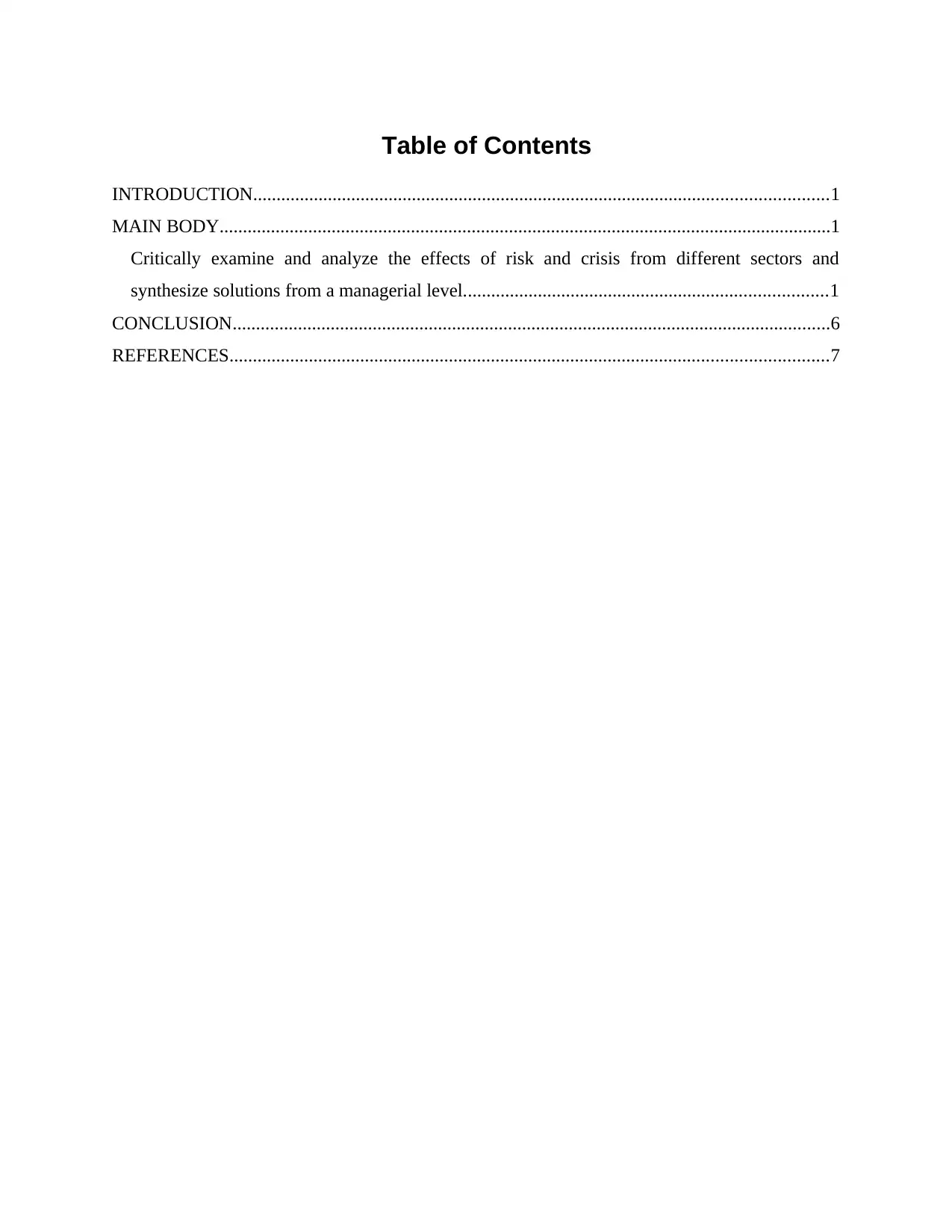
Table of Contents
INTRODUCTION...........................................................................................................................1
MAIN BODY...................................................................................................................................1
Critically examine and analyze the effects of risk and crisis from different sectors and
synthesize solutions from a managerial level..............................................................................1
CONCLUSION................................................................................................................................6
REFERENCES................................................................................................................................7
INTRODUCTION...........................................................................................................................1
MAIN BODY...................................................................................................................................1
Critically examine and analyze the effects of risk and crisis from different sectors and
synthesize solutions from a managerial level..............................................................................1
CONCLUSION................................................................................................................................6
REFERENCES................................................................................................................................7
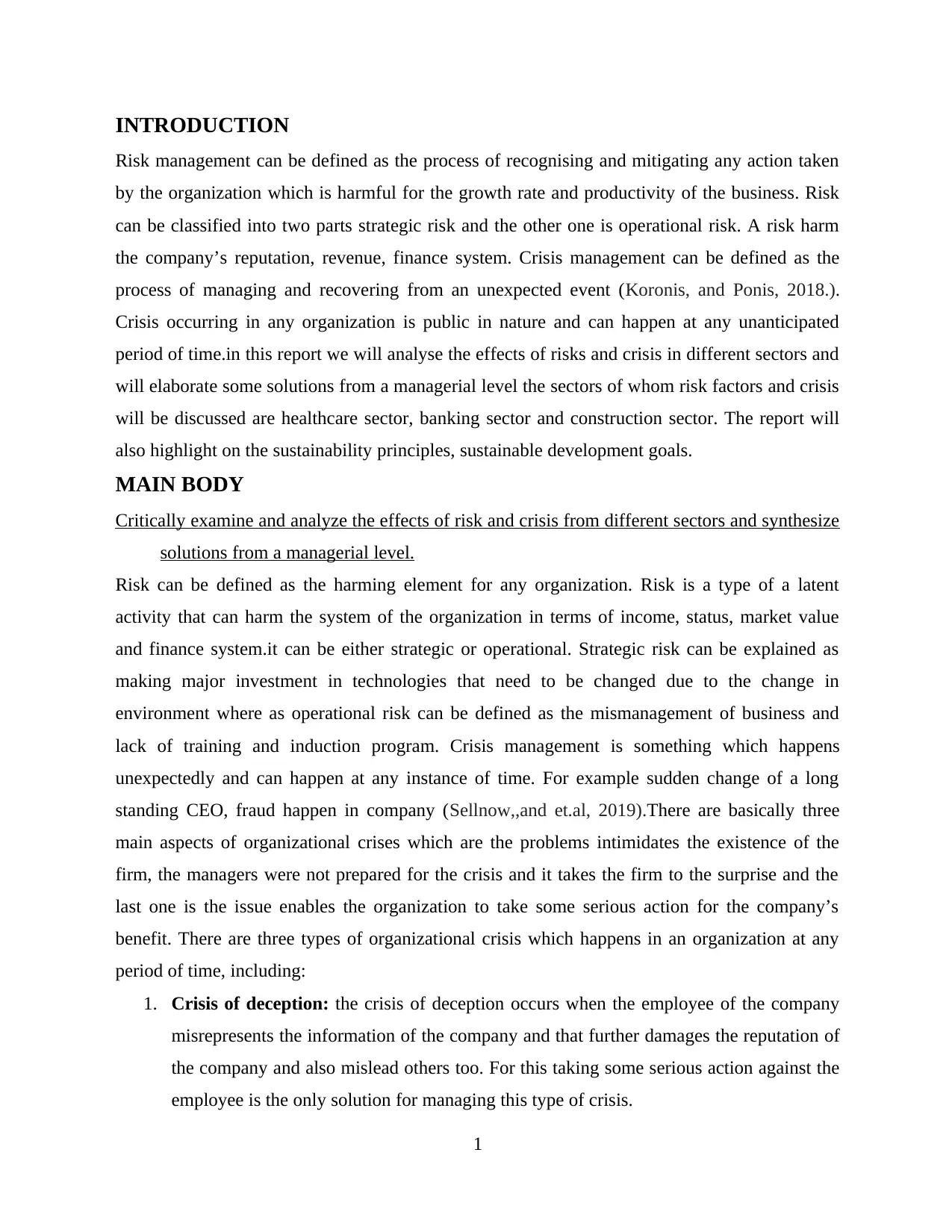
INTRODUCTION
Risk management can be defined as the process of recognising and mitigating any action taken
by the organization which is harmful for the growth rate and productivity of the business. Risk
can be classified into two parts strategic risk and the other one is operational risk. A risk harm
the company’s reputation, revenue, finance system. Crisis management can be defined as the
process of managing and recovering from an unexpected event (Koronis, and Ponis, 2018.).
Crisis occurring in any organization is public in nature and can happen at any unanticipated
period of time.in this report we will analyse the effects of risks and crisis in different sectors and
will elaborate some solutions from a managerial level the sectors of whom risk factors and crisis
will be discussed are healthcare sector, banking sector and construction sector. The report will
also highlight on the sustainability principles, sustainable development goals.
MAIN BODY
Critically examine and analyze the effects of risk and crisis from different sectors and synthesize
solutions from a managerial level.
Risk can be defined as the harming element for any organization. Risk is a type of a latent
activity that can harm the system of the organization in terms of income, status, market value
and finance system.it can be either strategic or operational. Strategic risk can be explained as
making major investment in technologies that need to be changed due to the change in
environment where as operational risk can be defined as the mismanagement of business and
lack of training and induction program. Crisis management is something which happens
unexpectedly and can happen at any instance of time. For example sudden change of a long
standing CEO, fraud happen in company (Sellnow,,and et.al, 2019).There are basically three
main aspects of organizational crises which are the problems intimidates the existence of the
firm, the managers were not prepared for the crisis and it takes the firm to the surprise and the
last one is the issue enables the organization to take some serious action for the company’s
benefit. There are three types of organizational crisis which happens in an organization at any
period of time, including:
1. Crisis of deception: the crisis of deception occurs when the employee of the company
misrepresents the information of the company and that further damages the reputation of
the company and also mislead others too. For this taking some serious action against the
employee is the only solution for managing this type of crisis.
1
Risk management can be defined as the process of recognising and mitigating any action taken
by the organization which is harmful for the growth rate and productivity of the business. Risk
can be classified into two parts strategic risk and the other one is operational risk. A risk harm
the company’s reputation, revenue, finance system. Crisis management can be defined as the
process of managing and recovering from an unexpected event (Koronis, and Ponis, 2018.).
Crisis occurring in any organization is public in nature and can happen at any unanticipated
period of time.in this report we will analyse the effects of risks and crisis in different sectors and
will elaborate some solutions from a managerial level the sectors of whom risk factors and crisis
will be discussed are healthcare sector, banking sector and construction sector. The report will
also highlight on the sustainability principles, sustainable development goals.
MAIN BODY
Critically examine and analyze the effects of risk and crisis from different sectors and synthesize
solutions from a managerial level.
Risk can be defined as the harming element for any organization. Risk is a type of a latent
activity that can harm the system of the organization in terms of income, status, market value
and finance system.it can be either strategic or operational. Strategic risk can be explained as
making major investment in technologies that need to be changed due to the change in
environment where as operational risk can be defined as the mismanagement of business and
lack of training and induction program. Crisis management is something which happens
unexpectedly and can happen at any instance of time. For example sudden change of a long
standing CEO, fraud happen in company (Sellnow,,and et.al, 2019).There are basically three
main aspects of organizational crises which are the problems intimidates the existence of the
firm, the managers were not prepared for the crisis and it takes the firm to the surprise and the
last one is the issue enables the organization to take some serious action for the company’s
benefit. There are three types of organizational crisis which happens in an organization at any
period of time, including:
1. Crisis of deception: the crisis of deception occurs when the employee of the company
misrepresents the information of the company and that further damages the reputation of
the company and also mislead others too. For this taking some serious action against the
employee is the only solution for managing this type of crisis.
1
⊘ This is a preview!⊘
Do you want full access?
Subscribe today to unlock all pages.

Trusted by 1+ million students worldwide
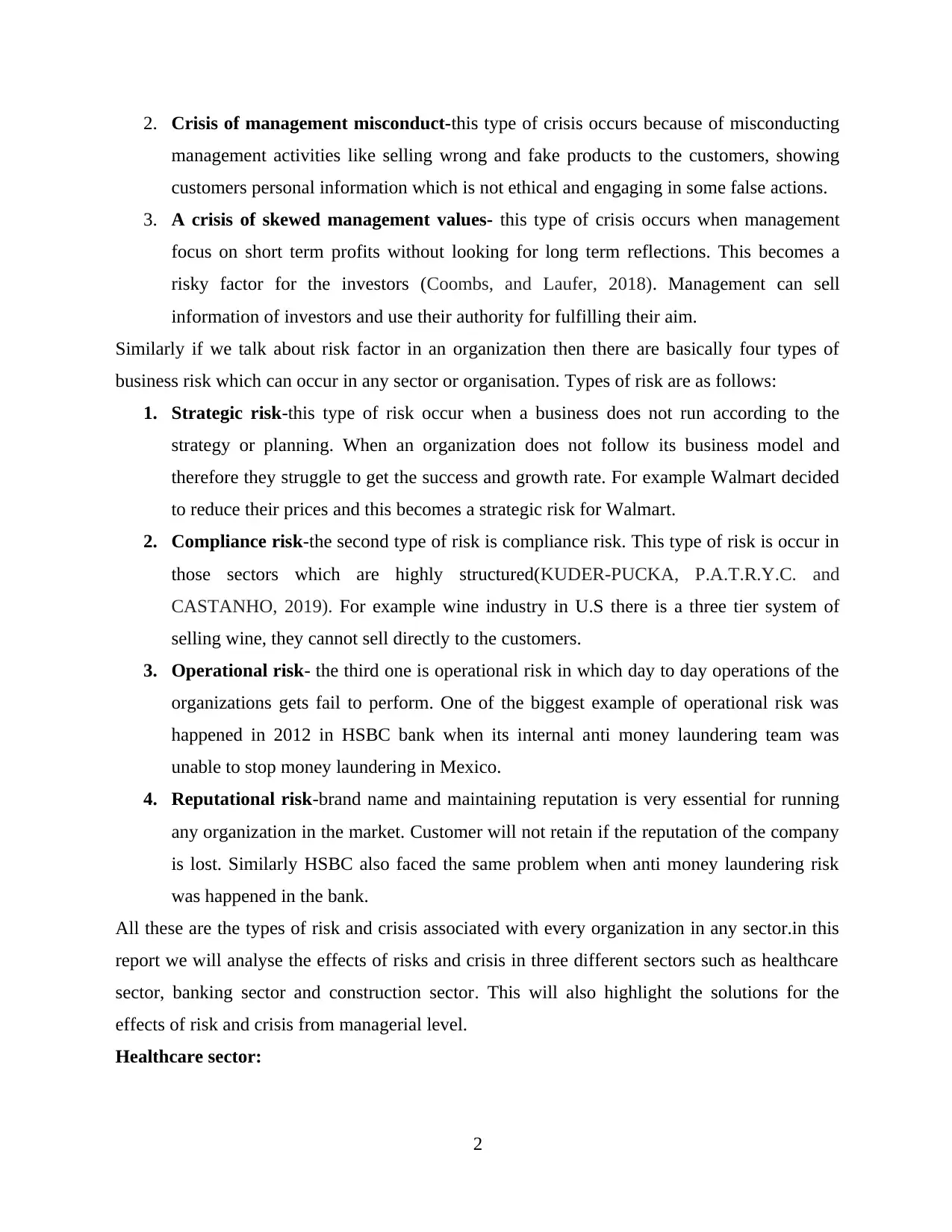
2. Crisis of management misconduct-this type of crisis occurs because of misconducting
management activities like selling wrong and fake products to the customers, showing
customers personal information which is not ethical and engaging in some false actions.
3. A crisis of skewed management values- this type of crisis occurs when management
focus on short term profits without looking for long term reflections. This becomes a
risky factor for the investors (Coombs, and Laufer, 2018). Management can sell
information of investors and use their authority for fulfilling their aim.
Similarly if we talk about risk factor in an organization then there are basically four types of
business risk which can occur in any sector or organisation. Types of risk are as follows:
1. Strategic risk-this type of risk occur when a business does not run according to the
strategy or planning. When an organization does not follow its business model and
therefore they struggle to get the success and growth rate. For example Walmart decided
to reduce their prices and this becomes a strategic risk for Walmart.
2. Compliance risk-the second type of risk is compliance risk. This type of risk is occur in
those sectors which are highly structured(KUDER-PUCKA, P.A.T.R.Y.C. and
CASTANHO, 2019). For example wine industry in U.S there is a three tier system of
selling wine, they cannot sell directly to the customers.
3. Operational risk- the third one is operational risk in which day to day operations of the
organizations gets fail to perform. One of the biggest example of operational risk was
happened in 2012 in HSBC bank when its internal anti money laundering team was
unable to stop money laundering in Mexico.
4. Reputational risk-brand name and maintaining reputation is very essential for running
any organization in the market. Customer will not retain if the reputation of the company
is lost. Similarly HSBC also faced the same problem when anti money laundering risk
was happened in the bank.
All these are the types of risk and crisis associated with every organization in any sector.in this
report we will analyse the effects of risks and crisis in three different sectors such as healthcare
sector, banking sector and construction sector. This will also highlight the solutions for the
effects of risk and crisis from managerial level.
Healthcare sector:
2
management activities like selling wrong and fake products to the customers, showing
customers personal information which is not ethical and engaging in some false actions.
3. A crisis of skewed management values- this type of crisis occurs when management
focus on short term profits without looking for long term reflections. This becomes a
risky factor for the investors (Coombs, and Laufer, 2018). Management can sell
information of investors and use their authority for fulfilling their aim.
Similarly if we talk about risk factor in an organization then there are basically four types of
business risk which can occur in any sector or organisation. Types of risk are as follows:
1. Strategic risk-this type of risk occur when a business does not run according to the
strategy or planning. When an organization does not follow its business model and
therefore they struggle to get the success and growth rate. For example Walmart decided
to reduce their prices and this becomes a strategic risk for Walmart.
2. Compliance risk-the second type of risk is compliance risk. This type of risk is occur in
those sectors which are highly structured(KUDER-PUCKA, P.A.T.R.Y.C. and
CASTANHO, 2019). For example wine industry in U.S there is a three tier system of
selling wine, they cannot sell directly to the customers.
3. Operational risk- the third one is operational risk in which day to day operations of the
organizations gets fail to perform. One of the biggest example of operational risk was
happened in 2012 in HSBC bank when its internal anti money laundering team was
unable to stop money laundering in Mexico.
4. Reputational risk-brand name and maintaining reputation is very essential for running
any organization in the market. Customer will not retain if the reputation of the company
is lost. Similarly HSBC also faced the same problem when anti money laundering risk
was happened in the bank.
All these are the types of risk and crisis associated with every organization in any sector.in this
report we will analyse the effects of risks and crisis in three different sectors such as healthcare
sector, banking sector and construction sector. This will also highlight the solutions for the
effects of risk and crisis from managerial level.
Healthcare sector:
2
Paraphrase This Document
Need a fresh take? Get an instant paraphrase of this document with our AI Paraphraser
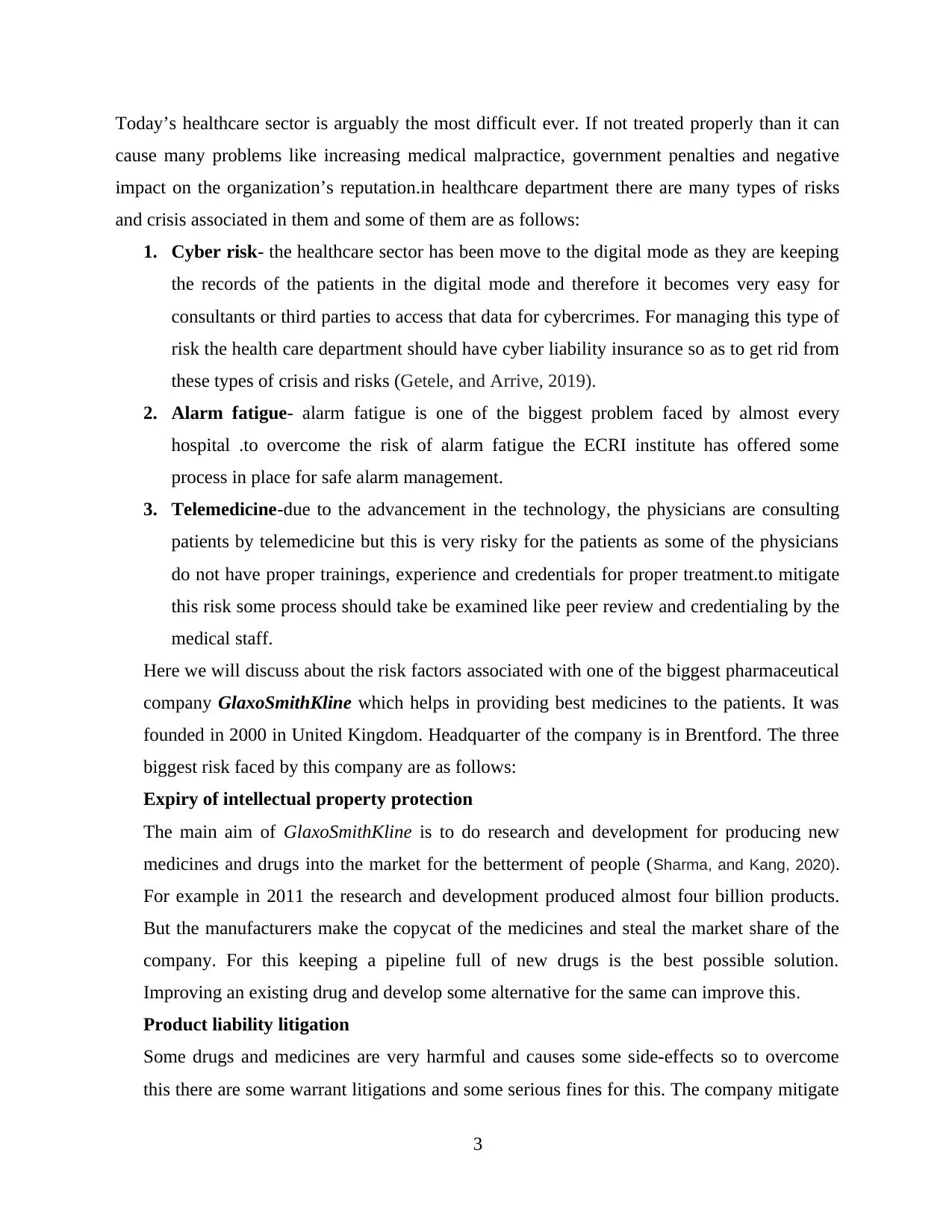
Today’s healthcare sector is arguably the most difficult ever. If not treated properly than it can
cause many problems like increasing medical malpractice, government penalties and negative
impact on the organization’s reputation.in healthcare department there are many types of risks
and crisis associated in them and some of them are as follows:
1. Cyber risk- the healthcare sector has been move to the digital mode as they are keeping
the records of the patients in the digital mode and therefore it becomes very easy for
consultants or third parties to access that data for cybercrimes. For managing this type of
risk the health care department should have cyber liability insurance so as to get rid from
these types of crisis and risks (Getele, and Arrive, 2019).
2. Alarm fatigue- alarm fatigue is one of the biggest problem faced by almost every
hospital .to overcome the risk of alarm fatigue the ECRI institute has offered some
process in place for safe alarm management.
3. Telemedicine-due to the advancement in the technology, the physicians are consulting
patients by telemedicine but this is very risky for the patients as some of the physicians
do not have proper trainings, experience and credentials for proper treatment.to mitigate
this risk some process should take be examined like peer review and credentialing by the
medical staff.
Here we will discuss about the risk factors associated with one of the biggest pharmaceutical
company GlaxoSmithKline which helps in providing best medicines to the patients. It was
founded in 2000 in United Kingdom. Headquarter of the company is in Brentford. The three
biggest risk faced by this company are as follows:
Expiry of intellectual property protection
The main aim of GlaxoSmithKline is to do research and development for producing new
medicines and drugs into the market for the betterment of people (Sharma, and Kang, 2020).
For example in 2011 the research and development produced almost four billion products.
But the manufacturers make the copycat of the medicines and steal the market share of the
company. For this keeping a pipeline full of new drugs is the best possible solution.
Improving an existing drug and develop some alternative for the same can improve this.
Product liability litigation
Some drugs and medicines are very harmful and causes some side-effects so to overcome
this there are some warrant litigations and some serious fines for this. The company mitigate
3
cause many problems like increasing medical malpractice, government penalties and negative
impact on the organization’s reputation.in healthcare department there are many types of risks
and crisis associated in them and some of them are as follows:
1. Cyber risk- the healthcare sector has been move to the digital mode as they are keeping
the records of the patients in the digital mode and therefore it becomes very easy for
consultants or third parties to access that data for cybercrimes. For managing this type of
risk the health care department should have cyber liability insurance so as to get rid from
these types of crisis and risks (Getele, and Arrive, 2019).
2. Alarm fatigue- alarm fatigue is one of the biggest problem faced by almost every
hospital .to overcome the risk of alarm fatigue the ECRI institute has offered some
process in place for safe alarm management.
3. Telemedicine-due to the advancement in the technology, the physicians are consulting
patients by telemedicine but this is very risky for the patients as some of the physicians
do not have proper trainings, experience and credentials for proper treatment.to mitigate
this risk some process should take be examined like peer review and credentialing by the
medical staff.
Here we will discuss about the risk factors associated with one of the biggest pharmaceutical
company GlaxoSmithKline which helps in providing best medicines to the patients. It was
founded in 2000 in United Kingdom. Headquarter of the company is in Brentford. The three
biggest risk faced by this company are as follows:
Expiry of intellectual property protection
The main aim of GlaxoSmithKline is to do research and development for producing new
medicines and drugs into the market for the betterment of people (Sharma, and Kang, 2020).
For example in 2011 the research and development produced almost four billion products.
But the manufacturers make the copycat of the medicines and steal the market share of the
company. For this keeping a pipeline full of new drugs is the best possible solution.
Improving an existing drug and develop some alternative for the same can improve this.
Product liability litigation
Some drugs and medicines are very harmful and causes some side-effects so to overcome
this there are some warrant litigations and some serious fines for this. The company mitigate
3
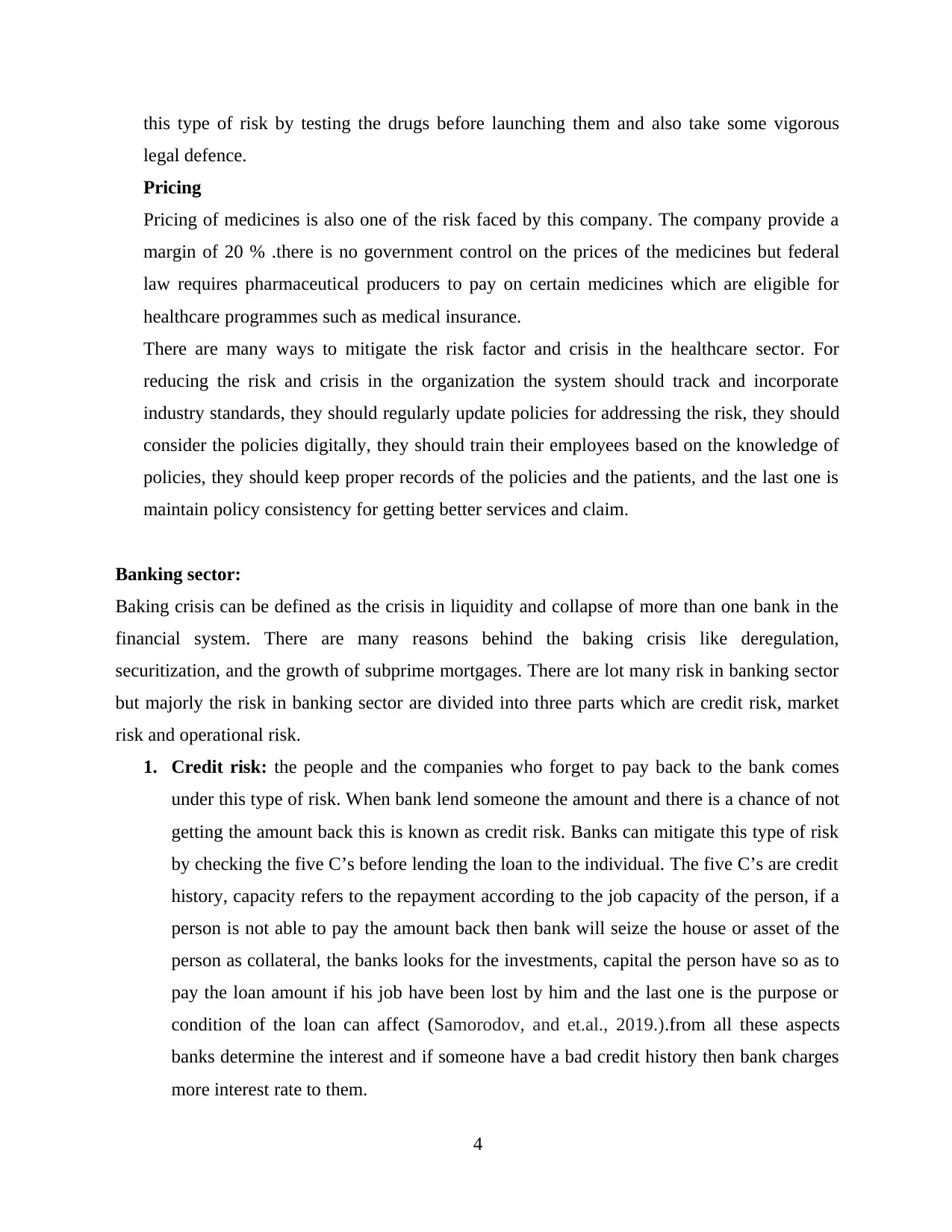
this type of risk by testing the drugs before launching them and also take some vigorous
legal defence.
Pricing
Pricing of medicines is also one of the risk faced by this company. The company provide a
margin of 20 % .there is no government control on the prices of the medicines but federal
law requires pharmaceutical producers to pay on certain medicines which are eligible for
healthcare programmes such as medical insurance.
There are many ways to mitigate the risk factor and crisis in the healthcare sector. For
reducing the risk and crisis in the organization the system should track and incorporate
industry standards, they should regularly update policies for addressing the risk, they should
consider the policies digitally, they should train their employees based on the knowledge of
policies, they should keep proper records of the policies and the patients, and the last one is
maintain policy consistency for getting better services and claim.
Banking sector:
Baking crisis can be defined as the crisis in liquidity and collapse of more than one bank in the
financial system. There are many reasons behind the baking crisis like deregulation,
securitization, and the growth of subprime mortgages. There are lot many risk in banking sector
but majorly the risk in banking sector are divided into three parts which are credit risk, market
risk and operational risk.
1. Credit risk: the people and the companies who forget to pay back to the bank comes
under this type of risk. When bank lend someone the amount and there is a chance of not
getting the amount back this is known as credit risk. Banks can mitigate this type of risk
by checking the five C’s before lending the loan to the individual. The five C’s are credit
history, capacity refers to the repayment according to the job capacity of the person, if a
person is not able to pay the amount back then bank will seize the house or asset of the
person as collateral, the banks looks for the investments, capital the person have so as to
pay the loan amount if his job have been lost by him and the last one is the purpose or
condition of the loan can affect (Samorodov, and et.al., 2019.).from all these aspects
banks determine the interest and if someone have a bad credit history then bank charges
more interest rate to them.
4
legal defence.
Pricing
Pricing of medicines is also one of the risk faced by this company. The company provide a
margin of 20 % .there is no government control on the prices of the medicines but federal
law requires pharmaceutical producers to pay on certain medicines which are eligible for
healthcare programmes such as medical insurance.
There are many ways to mitigate the risk factor and crisis in the healthcare sector. For
reducing the risk and crisis in the organization the system should track and incorporate
industry standards, they should regularly update policies for addressing the risk, they should
consider the policies digitally, they should train their employees based on the knowledge of
policies, they should keep proper records of the policies and the patients, and the last one is
maintain policy consistency for getting better services and claim.
Banking sector:
Baking crisis can be defined as the crisis in liquidity and collapse of more than one bank in the
financial system. There are many reasons behind the baking crisis like deregulation,
securitization, and the growth of subprime mortgages. There are lot many risk in banking sector
but majorly the risk in banking sector are divided into three parts which are credit risk, market
risk and operational risk.
1. Credit risk: the people and the companies who forget to pay back to the bank comes
under this type of risk. When bank lend someone the amount and there is a chance of not
getting the amount back this is known as credit risk. Banks can mitigate this type of risk
by checking the five C’s before lending the loan to the individual. The five C’s are credit
history, capacity refers to the repayment according to the job capacity of the person, if a
person is not able to pay the amount back then bank will seize the house or asset of the
person as collateral, the banks looks for the investments, capital the person have so as to
pay the loan amount if his job have been lost by him and the last one is the purpose or
condition of the loan can affect (Samorodov, and et.al., 2019.).from all these aspects
banks determine the interest and if someone have a bad credit history then bank charges
more interest rate to them.
4
⊘ This is a preview!⊘
Do you want full access?
Subscribe today to unlock all pages.

Trusted by 1+ million students worldwide
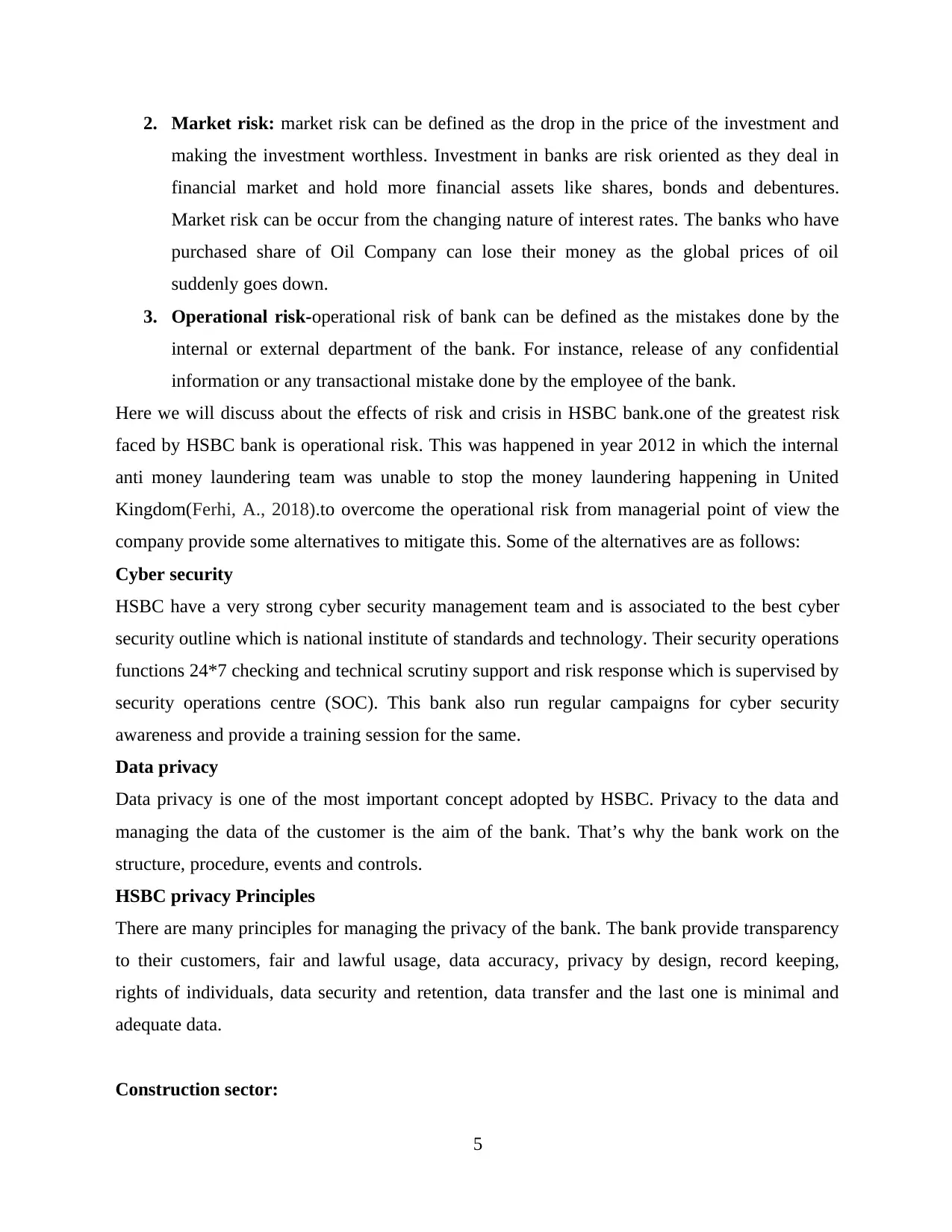
2. Market risk: market risk can be defined as the drop in the price of the investment and
making the investment worthless. Investment in banks are risk oriented as they deal in
financial market and hold more financial assets like shares, bonds and debentures.
Market risk can be occur from the changing nature of interest rates. The banks who have
purchased share of Oil Company can lose their money as the global prices of oil
suddenly goes down.
3. Operational risk-operational risk of bank can be defined as the mistakes done by the
internal or external department of the bank. For instance, release of any confidential
information or any transactional mistake done by the employee of the bank.
Here we will discuss about the effects of risk and crisis in HSBC bank.one of the greatest risk
faced by HSBC bank is operational risk. This was happened in year 2012 in which the internal
anti money laundering team was unable to stop the money laundering happening in United
Kingdom(Ferhi, A., 2018).to overcome the operational risk from managerial point of view the
company provide some alternatives to mitigate this. Some of the alternatives are as follows:
Cyber security
HSBC have a very strong cyber security management team and is associated to the best cyber
security outline which is national institute of standards and technology. Their security operations
functions 24*7 checking and technical scrutiny support and risk response which is supervised by
security operations centre (SOC). This bank also run regular campaigns for cyber security
awareness and provide a training session for the same.
Data privacy
Data privacy is one of the most important concept adopted by HSBC. Privacy to the data and
managing the data of the customer is the aim of the bank. That’s why the bank work on the
structure, procedure, events and controls.
HSBC privacy Principles
There are many principles for managing the privacy of the bank. The bank provide transparency
to their customers, fair and lawful usage, data accuracy, privacy by design, record keeping,
rights of individuals, data security and retention, data transfer and the last one is minimal and
adequate data.
Construction sector:
5
making the investment worthless. Investment in banks are risk oriented as they deal in
financial market and hold more financial assets like shares, bonds and debentures.
Market risk can be occur from the changing nature of interest rates. The banks who have
purchased share of Oil Company can lose their money as the global prices of oil
suddenly goes down.
3. Operational risk-operational risk of bank can be defined as the mistakes done by the
internal or external department of the bank. For instance, release of any confidential
information or any transactional mistake done by the employee of the bank.
Here we will discuss about the effects of risk and crisis in HSBC bank.one of the greatest risk
faced by HSBC bank is operational risk. This was happened in year 2012 in which the internal
anti money laundering team was unable to stop the money laundering happening in United
Kingdom(Ferhi, A., 2018).to overcome the operational risk from managerial point of view the
company provide some alternatives to mitigate this. Some of the alternatives are as follows:
Cyber security
HSBC have a very strong cyber security management team and is associated to the best cyber
security outline which is national institute of standards and technology. Their security operations
functions 24*7 checking and technical scrutiny support and risk response which is supervised by
security operations centre (SOC). This bank also run regular campaigns for cyber security
awareness and provide a training session for the same.
Data privacy
Data privacy is one of the most important concept adopted by HSBC. Privacy to the data and
managing the data of the customer is the aim of the bank. That’s why the bank work on the
structure, procedure, events and controls.
HSBC privacy Principles
There are many principles for managing the privacy of the bank. The bank provide transparency
to their customers, fair and lawful usage, data accuracy, privacy by design, record keeping,
rights of individuals, data security and retention, data transfer and the last one is minimal and
adequate data.
Construction sector:
5
Paraphrase This Document
Need a fresh take? Get an instant paraphrase of this document with our AI Paraphraser

Construction sector is very complex and have multiple risk associated within them. There are
some internal and external risk in construction sector which occur at unexpected period of time
(Torrents Arévalo, 2021). Managing these types of risk is very important in terms of cost, time,
quality, safety and environmental sustainability. There are multiple types of risk and some of
them are as follows:
1. Environmental risk- environmental risk is also known as act of god risk. These types of
risk arises due to flood, cyclone, landslides, pandemics and any type of natural disaster.
These risk are not in control of anyone and can happen at any instance of time.
2. Finance and economic risk-these type of risk involve fiancé and investment risk.
Inflation also comes under these types of risk, change in tax structure, change in
currencies, change in royalty structure of stone are the types of finance and economic
risk.
3. Socio political and legal risk-the site area where construction is going on is politically
driven. Change in laws, import export restrictions, requirement for licence, safety and
pollution norms all comes under socio political and legal risk.
4. Health and safety risk- keeping the employees safe is utmost priority of the company.
At construction site it is very important to take care of the health and keep safety for
them as it is very risky to work at heights.
5. Change order-change order is one of the important part of construction and can be a
major risk factor when it is not managed by the employee of the company. A change
order is an amendment to the original contract of the construction. This can be done by
the owner, contractors or sub-contractors. Increased in project price, delays in hitting the
timeline of the construction and not completing the work on time all are the issues
caused by change order.
Here we will talk about one of the multinational construction company Bouygues construction.
Risk is managed very deeply at this company and there are multiple risk at different stages like
construction site, process, operational units and this can also take different forms like SWOT
analysis. Each risk occurring in the company is identified and evaluated on the basis of
occurrence and its financial impact. The risk can be identifies as macro risk which include the
ethics, rules and regulations ,policies of the company whereas the operational risk include the
major construction projects, cyber security(El Moussaoui, and et.al., 2021). There is another risk
6
some internal and external risk in construction sector which occur at unexpected period of time
(Torrents Arévalo, 2021). Managing these types of risk is very important in terms of cost, time,
quality, safety and environmental sustainability. There are multiple types of risk and some of
them are as follows:
1. Environmental risk- environmental risk is also known as act of god risk. These types of
risk arises due to flood, cyclone, landslides, pandemics and any type of natural disaster.
These risk are not in control of anyone and can happen at any instance of time.
2. Finance and economic risk-these type of risk involve fiancé and investment risk.
Inflation also comes under these types of risk, change in tax structure, change in
currencies, change in royalty structure of stone are the types of finance and economic
risk.
3. Socio political and legal risk-the site area where construction is going on is politically
driven. Change in laws, import export restrictions, requirement for licence, safety and
pollution norms all comes under socio political and legal risk.
4. Health and safety risk- keeping the employees safe is utmost priority of the company.
At construction site it is very important to take care of the health and keep safety for
them as it is very risky to work at heights.
5. Change order-change order is one of the important part of construction and can be a
major risk factor when it is not managed by the employee of the company. A change
order is an amendment to the original contract of the construction. This can be done by
the owner, contractors or sub-contractors. Increased in project price, delays in hitting the
timeline of the construction and not completing the work on time all are the issues
caused by change order.
Here we will talk about one of the multinational construction company Bouygues construction.
Risk is managed very deeply at this company and there are multiple risk at different stages like
construction site, process, operational units and this can also take different forms like SWOT
analysis. Each risk occurring in the company is identified and evaluated on the basis of
occurrence and its financial impact. The risk can be identifies as macro risk which include the
ethics, rules and regulations ,policies of the company whereas the operational risk include the
major construction projects, cyber security(El Moussaoui, and et.al., 2021). There is another risk
6
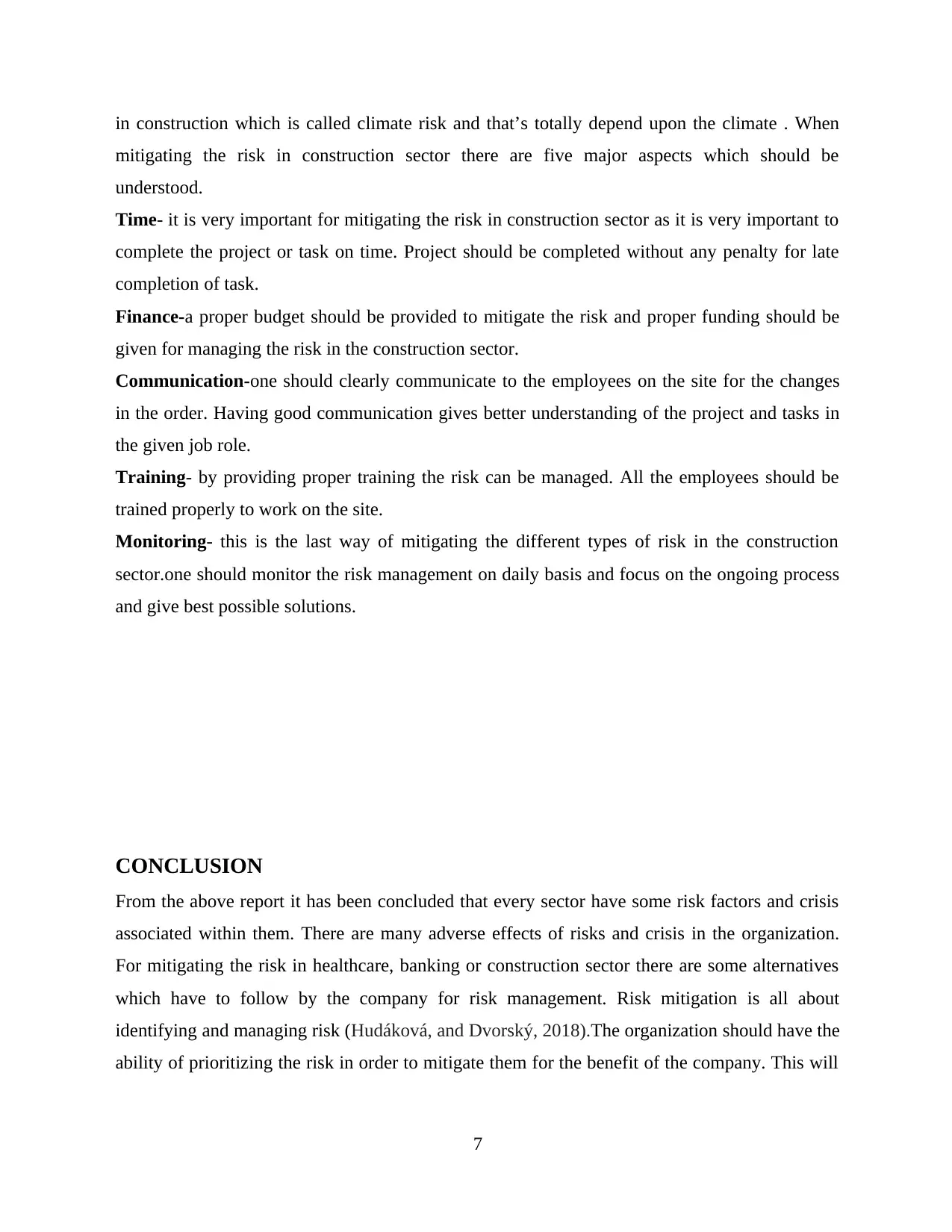
in construction which is called climate risk and that’s totally depend upon the climate . When
mitigating the risk in construction sector there are five major aspects which should be
understood.
Time- it is very important for mitigating the risk in construction sector as it is very important to
complete the project or task on time. Project should be completed without any penalty for late
completion of task.
Finance-a proper budget should be provided to mitigate the risk and proper funding should be
given for managing the risk in the construction sector.
Communication-one should clearly communicate to the employees on the site for the changes
in the order. Having good communication gives better understanding of the project and tasks in
the given job role.
Training- by providing proper training the risk can be managed. All the employees should be
trained properly to work on the site.
Monitoring- this is the last way of mitigating the different types of risk in the construction
sector.one should monitor the risk management on daily basis and focus on the ongoing process
and give best possible solutions.
CONCLUSION
From the above report it has been concluded that every sector have some risk factors and crisis
associated within them. There are many adverse effects of risks and crisis in the organization.
For mitigating the risk in healthcare, banking or construction sector there are some alternatives
which have to follow by the company for risk management. Risk mitigation is all about
identifying and managing risk (Hudáková, and Dvorský, 2018).The organization should have the
ability of prioritizing the risk in order to mitigate them for the benefit of the company. This will
7
mitigating the risk in construction sector there are five major aspects which should be
understood.
Time- it is very important for mitigating the risk in construction sector as it is very important to
complete the project or task on time. Project should be completed without any penalty for late
completion of task.
Finance-a proper budget should be provided to mitigate the risk and proper funding should be
given for managing the risk in the construction sector.
Communication-one should clearly communicate to the employees on the site for the changes
in the order. Having good communication gives better understanding of the project and tasks in
the given job role.
Training- by providing proper training the risk can be managed. All the employees should be
trained properly to work on the site.
Monitoring- this is the last way of mitigating the different types of risk in the construction
sector.one should monitor the risk management on daily basis and focus on the ongoing process
and give best possible solutions.
CONCLUSION
From the above report it has been concluded that every sector have some risk factors and crisis
associated within them. There are many adverse effects of risks and crisis in the organization.
For mitigating the risk in healthcare, banking or construction sector there are some alternatives
which have to follow by the company for risk management. Risk mitigation is all about
identifying and managing risk (Hudáková, and Dvorský, 2018).The organization should have the
ability of prioritizing the risk in order to mitigate them for the benefit of the company. This will
7
⊘ This is a preview!⊘
Do you want full access?
Subscribe today to unlock all pages.

Trusted by 1+ million students worldwide
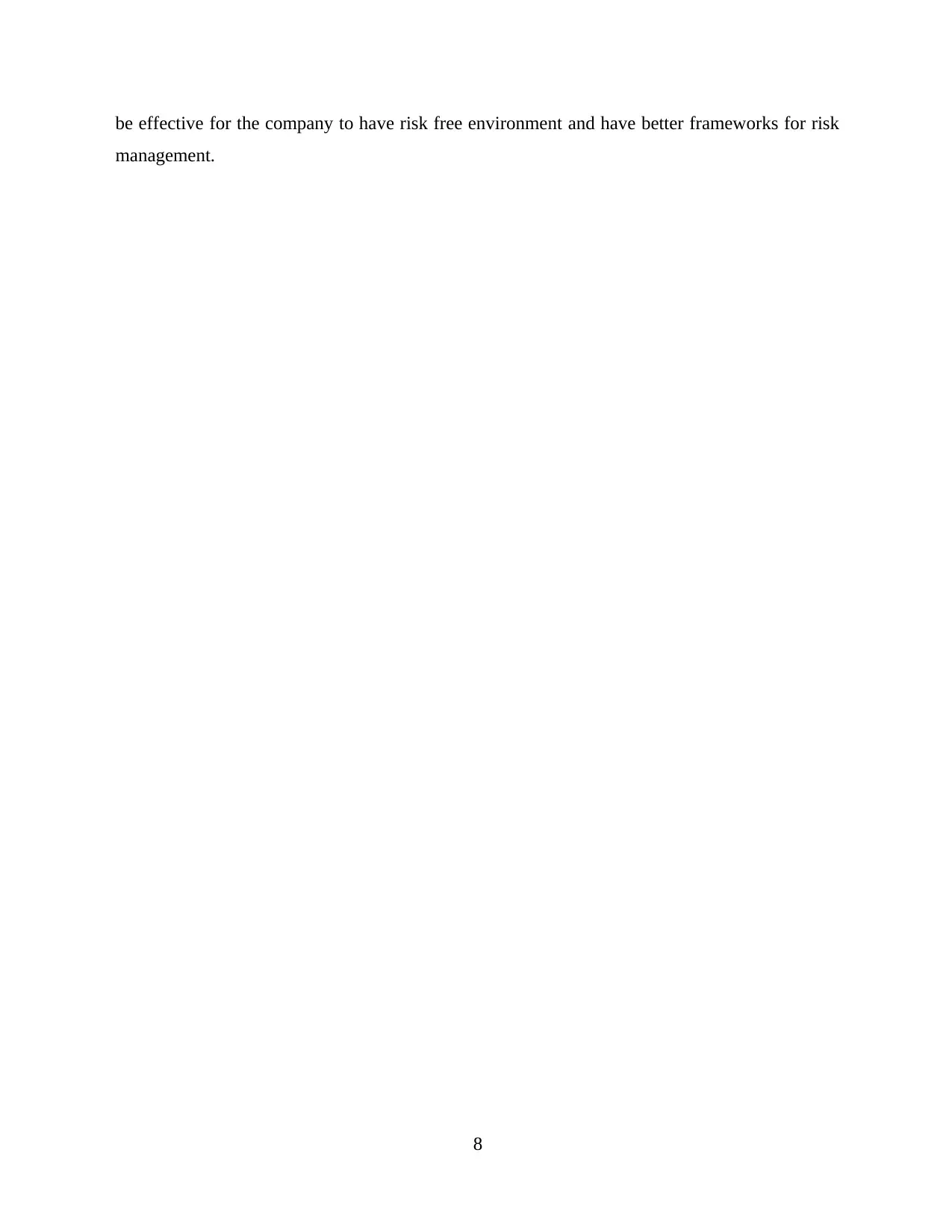
be effective for the company to have risk free environment and have better frameworks for risk
management.
8
management.
8
Paraphrase This Document
Need a fresh take? Get an instant paraphrase of this document with our AI Paraphraser
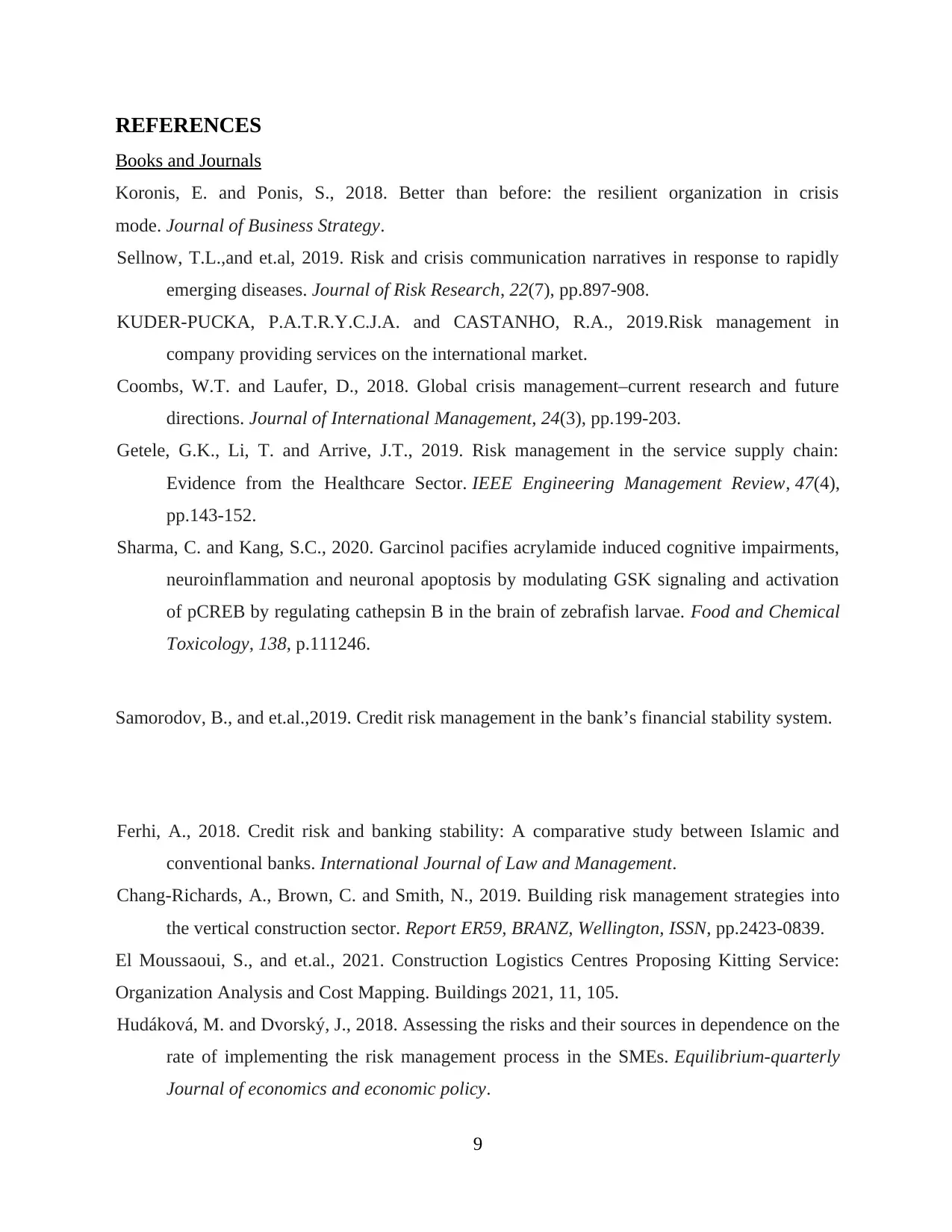
REFERENCES
Books and Journals
Koronis, E. and Ponis, S., 2018. Better than before: the resilient organization in crisis
mode. Journal of Business Strategy.
Sellnow, T.L.,and et.al, 2019. Risk and crisis communication narratives in response to rapidly
emerging diseases. Journal of Risk Research, 22(7), pp.897-908.
KUDER-PUCKA, P.A.T.R.Y.C.J.A. and CASTANHO, R.A., 2019.Risk management in
company providing services on the international market.
Coombs, W.T. and Laufer, D., 2018. Global crisis management–current research and future
directions. Journal of International Management, 24(3), pp.199-203.
Getele, G.K., Li, T. and Arrive, J.T., 2019. Risk management in the service supply chain:
Evidence from the Healthcare Sector. IEEE Engineering Management Review, 47(4),
pp.143-152.
Sharma, C. and Kang, S.C., 2020. Garcinol pacifies acrylamide induced cognitive impairments,
neuroinflammation and neuronal apoptosis by modulating GSK signaling and activation
of pCREB by regulating cathepsin B in the brain of zebrafish larvae. Food and Chemical
Toxicology, 138, p.111246.
Samorodov, B., and et.al.,2019. Credit risk management in the bank’s financial stability system.
Ferhi, A., 2018. Credit risk and banking stability: A comparative study between Islamic and
conventional banks. International Journal of Law and Management.
Chang-Richards, A., Brown, C. and Smith, N., 2019. Building risk management strategies into
the vertical construction sector. Report ER59, BRANZ, Wellington, ISSN, pp.2423-0839.
El Moussaoui, S., and et.al., 2021. Construction Logistics Centres Proposing Kitting Service:
Organization Analysis and Cost Mapping. Buildings 2021, 11, 105.
Hudáková, M. and Dvorský, J., 2018. Assessing the risks and their sources in dependence on the
rate of implementing the risk management process in the SMEs. Equilibrium-quarterly
Journal of economics and economic policy.
9
Books and Journals
Koronis, E. and Ponis, S., 2018. Better than before: the resilient organization in crisis
mode. Journal of Business Strategy.
Sellnow, T.L.,and et.al, 2019. Risk and crisis communication narratives in response to rapidly
emerging diseases. Journal of Risk Research, 22(7), pp.897-908.
KUDER-PUCKA, P.A.T.R.Y.C.J.A. and CASTANHO, R.A., 2019.Risk management in
company providing services on the international market.
Coombs, W.T. and Laufer, D., 2018. Global crisis management–current research and future
directions. Journal of International Management, 24(3), pp.199-203.
Getele, G.K., Li, T. and Arrive, J.T., 2019. Risk management in the service supply chain:
Evidence from the Healthcare Sector. IEEE Engineering Management Review, 47(4),
pp.143-152.
Sharma, C. and Kang, S.C., 2020. Garcinol pacifies acrylamide induced cognitive impairments,
neuroinflammation and neuronal apoptosis by modulating GSK signaling and activation
of pCREB by regulating cathepsin B in the brain of zebrafish larvae. Food and Chemical
Toxicology, 138, p.111246.
Samorodov, B., and et.al.,2019. Credit risk management in the bank’s financial stability system.
Ferhi, A., 2018. Credit risk and banking stability: A comparative study between Islamic and
conventional banks. International Journal of Law and Management.
Chang-Richards, A., Brown, C. and Smith, N., 2019. Building risk management strategies into
the vertical construction sector. Report ER59, BRANZ, Wellington, ISSN, pp.2423-0839.
El Moussaoui, S., and et.al., 2021. Construction Logistics Centres Proposing Kitting Service:
Organization Analysis and Cost Mapping. Buildings 2021, 11, 105.
Hudáková, M. and Dvorský, J., 2018. Assessing the risks and their sources in dependence on the
rate of implementing the risk management process in the SMEs. Equilibrium-quarterly
Journal of economics and economic policy.
9
1 out of 11
Related Documents
Your All-in-One AI-Powered Toolkit for Academic Success.
+13062052269
info@desklib.com
Available 24*7 on WhatsApp / Email
![[object Object]](/_next/static/media/star-bottom.7253800d.svg)
Unlock your academic potential
Copyright © 2020–2025 A2Z Services. All Rights Reserved. Developed and managed by ZUCOL.





